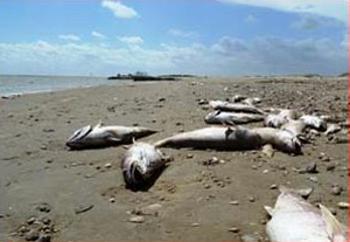HONG KONG, China,
August 14, 2012 (ENS) – Hong Kong Chief Executive Leung Chun-ying says
he supports the investigation into who is responsible for the plastic
pellet spill, in which around 150 tonnes of plastic were dumped into the
sea.
Hong
Kong officials have said repeatedly that the plastic pellets pose no
immediate threat to food and environmental safety. But environmentalists
warn that the pellets, known as nurdles, can absorb pollutants from sea
water, thus becoming toxic themselves.
Leung said is concerned about the spill and has maintained close contact with government departments involved in the cleanup.
Chief Secretary Carrie Lam said, “The Department of Justice together with the Marine Department are discussing the matter, tracing the whole incident, and looking at various parties involved.”
Overnight July 23-24 the plastic pellets were being shipped from Guangzhou to Shantou, both in southern China’s Guangdong Province, when the cargo ship Yong Xin Jie 1 ran into Typhoon Vicente, the worst storm to strike Hong Kong in more than a decade.
Seven 40-foot-long containers were lost overboard in the waters south of Hong Kong.
Six of the containers contained sacks of small plastic pellets used in the manufacture of other plastic products, about 150 tonnes in total, according to Hong Kong environmental authorities. One container held bottles.
Five of the containers full of plastic pellets were located by the Hong Kong Marine Department, which salvaged the containers and the plastic pellets at sea.
About 50 tonnes of pellets in 25 kg sacks were collected from the water, but many of the sacks that were still adrift broke open, releasing tonnes of the pellets that piled up in great white drifts across 10 Hong Kong beaches or scattered across the sand.
The sixth container known to hold sacks of plastic pellets is still missing.
The Xiamen-registered Yong Xin Jie 1 was leased to shipping agent China Shipping Container Lines at the time of the incident.
Leung said is concerned about the spill and has maintained close contact with government departments involved in the cleanup.
Chief Secretary Carrie Lam said, “The Department of Justice together with the Marine Department are discussing the matter, tracing the whole incident, and looking at various parties involved.”
Overnight July 23-24 the plastic pellets were being shipped from Guangzhou to Shantou, both in southern China’s Guangdong Province, when the cargo ship Yong Xin Jie 1 ran into Typhoon Vicente, the worst storm to strike Hong Kong in more than a decade.
Seven 40-foot-long containers were lost overboard in the waters south of Hong Kong.
Six of the containers contained sacks of small plastic pellets used in the manufacture of other plastic products, about 150 tonnes in total, according to Hong Kong environmental authorities. One container held bottles.
Five of the containers full of plastic pellets were located by the Hong Kong Marine Department, which salvaged the containers and the plastic pellets at sea.
About 50 tonnes of pellets in 25 kg sacks were collected from the water, but many of the sacks that were still adrift broke open, releasing tonnes of the pellets that piled up in great white drifts across 10 Hong Kong beaches or scattered across the sand.
The sixth container known to hold sacks of plastic pellets is still missing.
The Xiamen-registered Yong Xin Jie 1 was leased to shipping agent China Shipping Container Lines at the time of the incident.
On
Thursday, petroleum giant Sinopec, the company that produced the
plastic pellets, pledged to establish a HK$10 million (US$1.3 million)
fund to locate and salvage the missing sixth container and clean up the
remaining pellets.
Lu
Dapeng, a spokesman for Sinopec, said it was up to judicial and
administrative authorities to determine who is responsible for the
incident. He urged the shipping agent and carriers to provide incident
reports as soon as possible.
Lu said
the company was deeply worried over the spill incident which led to
environmental impact and caused disturbance and inconvenience for Hong
Kong residents. He said the company’s top priority is to find the
missing container and halt further pollution.
So far,
about 21 tonnes of the plastic pellets washed ashore have been cleared.
Together with those collected by the Marine Department at sea, about
half of the plastic pellets have been cleared. Some have been
landfilled, but some of the pellets will be recycled, according to the
Hong Kong Environment Department.
Chief
Executive Leung told reporters the pellets must be cleared and attention
should be paid to whether fish farm operators need assistance from the
city government. Lam said the city government would provide support to
those in the mariculture industry affected by the spill.
The Hong
Kong government last week said the cleanup could take months. The Marine
Department will continue helicopter searches, step up patrols along the
coastline and arrange reinforcement from other districts to tackle the
incident.
